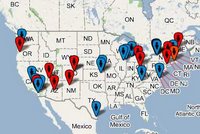
It's always a pleasure to hear about other physicians who are choosing to go smaller and return to a simpler way of practicing medicine via micropractices. For one thing, it gives me hope that the American medical system can be transformed/reformed into something that makes some sense. For another, it makes me feel like I'm not the only crazy one for trying it.
Here is a recent article from the Santa Cruz Sentinel about someone else who took the leap:
SANTA CRUZ - There's something different about the office of Dr. Maria Greaves.
Sure, there's a tastefully furnished waiting room with a burgundy leather sofa and a toy box. But there's no receptionist, no nurse, no insurance paperwork to fill out.
"I'm everything," said Greaves with a smile.
She is the first physician in Santa Cruz County to adopt a new style of medical practice pioneered by Dr. Gordon Moore in Rochester, N.Y., five years ago.
Here is another article about 2 doctors from Oregon who also decided smaller is better:
Quillin is part of a growing national trend of physicians breaking away from high-volume practices characterized by short office visits.
Tired of seeing more than 20 patients a day and staying on top of the well-being of 2,500 people every year, they are paring down their practices to a few hundred patients, who get a lot more of their time.
Smaller practices can come in different forms. Some are completely solo like Dr. Greaves and myself. Others look like a traditional practice with a medical assistant and nurse. I accept 3rd party insurance like most practices. Dr. Quillen charges a $400 annual enrollment fee plus $75 per additional family member. You can be full-time, or part-time, like Dr. Wible:
Wible worked in several clinics in Eugene and in Washington state before opening her own part-time practice in April.
Her biggest complaint about working in established clinics was similar to Quillin's: not enough face time with patients.
"I like to talk and my patients like to talk. They want to get to know me, and I want to get to know them. You can't do that in 15 minutes," she said.
When she decided to go solo, she conducted several community meetings that attracted about 100 people. She asked them what they wanted from their primary care physician and three consistent themes emerged.
People wanted more time with their doctors. They wanted to be listened to and they wanted to play a role in their own health care.
Wible knew she wanted more time with her patients, the opportunity to help transform the health care system, and more personal time to explore other activities.
To get there, she stripped down the overhead. She employs no one, and does all the accounting and business work in her home office. She sees clients three days a week in an office she rents at the Tamarack Wellness Center in south Eugene.
Because she carries no debt and lives simply, Wible says she doesn't need the typical physician's salary. But she believes that her low overhead will allow her to exceed her previous full-time salary.
So if this is a growing trend, where are all these micropractices?
Well, you could start by looking at this website where
You may already have a micropractice near you. Or if not, maybe a micropractice will be starting up in your town soon. Then you'll have a choice between the new way of seeing a doctor:
- call to make an appointment and be surprised when the doctor answers
- get an appointment for 2PM that same day
- barely spend any time reading the magazines in the empty waiting room as you are directed to the exam room
- talk to the doctor who sits down and looks you in the eye and actually listens
- spend enough time to make sure everything gets brought up and even some things that you had forgotten about
- receive a thorough physical examination
- leave with all questions answered with an appropriate follow up date (if any is needed)
- since it's only 2:30PM you have time to go to the bank/post office/whatever
- call for an appointment and wait on hold
- get an appointment for 2PM a week from now
- wait in crowded waiting room with sick people
- finally get called 30 minutes after the appointment time
- wait another 10 minutes for the doctor in the cold exam room
- spend 5 minutes with doctor who is busy looking through your chart or writing notes while you talk for 22 seconds before being interrupted
- received a rushed and abbreviated physical examination
- be left with unanswered questions because the doctor is late for his next patient
- spend another 10 minutes trying to reschedule another appointment because there wasn't enough time to talk about everything you wanted
- lather, rinse, repeat


